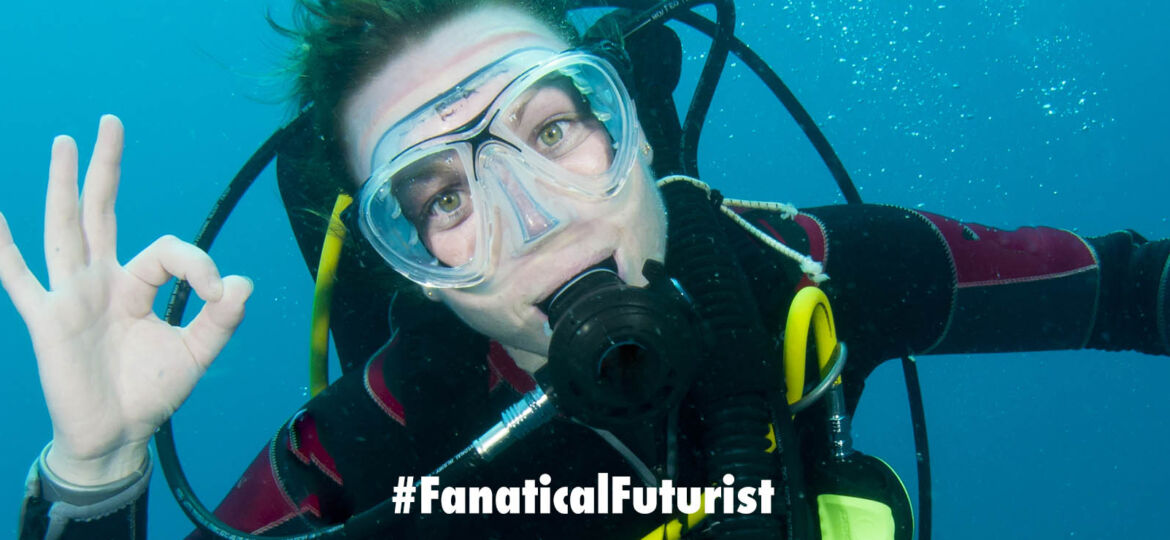
WHY THIS MATTERS IN BRIEF
Scuba divers still rely on crude hand signals, but now thanks to a new communications technology they can text one another and it’s a game changer.
 Love the Exponential Future? Join our XPotential Community, future proof yourself with courses from XPotential University, read about exponential tech and trends, connect, watch a keynote, or browse my blog.
Love the Exponential Future? Join our XPotential Community, future proof yourself with courses from XPotential University, read about exponential tech and trends, connect, watch a keynote, or browse my blog.
While communications technologies like 5G and space based internet from the likes of T-Mobile and SpaceX get a lot of attention ironically there are still huge parts of the world where even these most advanced of technologies can’t reach. Namely, the oceans and deep oceans. This is why for years organisations like the US military’s bleeding edge research arm DARPA have been running multi-million dollar competitions to find new ways to help the world’s most advanced tactical nuclear submarines communicate with one another using technologies such as Ultra Low Frequency communications.
But now, when it comes to ocean based communication at least there’s a new technology in town and for the first time it lets scuba divers text one another underwater – a genuine revelation.
You may not have given much thought to being able to text underwater, but for millions of scuba diving and snorkelling enthusiasts, communication in the ocean is pretty essential to staying safe.
Right now, hand gestures are the preferred way of keeping in touch under the waves, and professional divers use a globally recognized vocabulary of more than 200 of them, covering everything from “Are you okay?” to “End the dive”. However, these don’t work well over longer distances or when visibility is poor.
With those limitations in mind, researchers have developed a special smartphone app that uses acoustic signals to enable people to stay in touch underwater.
“Smartphones rely on radio signals like Wi-Fi and Bluetooth for wireless communication,” says computer science graduate student Tuochao Chen from the University of Washington in Seattle. “Those don’t propagate well underwater, but acoustic signals do.”
An underwater texting revolution
Acoustic signalling isn’t new, but it previously required expensive specialized hardware. Not anymore.
“Other than downloading an app to their phone, the only thing people will need is a waterproof phone case rated for the depth of their dive,” says Chen.
That app is AquaApp, and it can work with speakers and microphones on ordinary smartphones – or even smartwatches. It gives users 240 preset messages to pick from, split into eight categories for easier access.
There were numerous engineering challenges that the team had to deal with: reflections from the surface, the floor, and the coastline affecting signal strength; motion caused by people and other objects in the water which can interfere with signal transmission; and different microphone and speaker setups found between smartphone models.
On top of that, smartphones and smartwatches used to send and receive messages are likely to be always shifting position under the water.
All these factors are taken into account in AquaApp’s algorithm, which weighs up the distance between communicating devices and possible interference before sending a message.
The app does this through a ‘preamble’ that establishes contact between two devices. Having established the best conditions for messaging, the communication can then be sent, overcoming obstacles like motion and reflection.
“We had to adapt in real time to these and other factors to ensure AquaApp would work under real-world conditions,” says computer science graduate student Justin Chan from the University of Washington.
The developers worked on their own networking protocol to support the app, similar to protocols used by home WiFi routers. Up to 60 different users can be supported on each network at any given time.
In tests in a variety of scenarios, the team found the app was effective at communicating messages across a distance of 30 meters (98 feet). For shorter-length messages – emergency SOS messages, for example – the app can go up to 100 meters (nearly 330 feet). This is all managed without a huge drain on battery life.
More software development is going to be required before this will be available on app stores, but if you know a little bit about coding, you can install the open source code on an Android handset and test it out for yourself.
“The state of underwater networking today is similar to ARPANET, the precursor of the internet, in the 1970s, where only a select few had access to the internet,” says computer scientist Shyam Gollakota from the University of Washington.
“AquaApp has the potential to change that status quo by democratizing underwater technology and making it as easy as downloading software on your smartphone.”
The researchers presented a paper on their work at the ACM SIGCOMM 2022 conference.
















